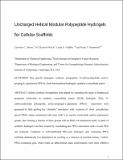| dc.contributor.author | Ahrens, Caroline C. | |
| dc.contributor.author | Welch, M. Elizabeth | |
| dc.contributor.author | Griffith, Linda G | |
| dc.contributor.author | Hammond, Paula T | |
| dc.date.accessioned | 2017-02-15T15:33:04Z | |
| dc.date.available | 2017-02-15T15:33:04Z | |
| dc.date.issued | 2015-10 | |
| dc.date.submitted | 2015-08 | |
| dc.identifier.issn | 1525-7797 | |
| dc.identifier.issn | 1526-4602 | |
| dc.identifier.uri | http://hdl.handle.net/1721.1/106938 | |
| dc.description.abstract | Grafted synthetic polypeptides hold appeal for extending the range of biophysical properties achievable in synthetic extracellular matrix (ECM) hydrogels. Here, N-carboxyanhydride polypeptide, poly(γ-propargyl-l-glutamate) (PPLG) macromers were generated by fully grafting the “clickable” side chains with mixtures of short polyethylene glycol (PEG) chains terminated with inert (−OH) or reactive (maleimide and/or norbornene) groups, then reacting a fraction of these groups with an RGD cell attachment motif. A panel of synthetic hydrogels was then created by cross-linking the PPLG macromers with a 4-arm PEG star molecule. Compared to well-established PEG-only hydrogels, gels containing PPLG exhibited dramatically less dependence on swelling as a function of cross-link density. Further, PPLG-containing gels, which retain an α-helical chain conformation, were more effective than standard PEG gels in fostering attachment of a human mesenchymal stem cell (hMSC) line for a given concentration of RGD in the gel. These favorable properties of PPLG-containing PEG hydrogels suggest they may find broad use in synthetic ECM. | en_US |
| dc.description.sponsorship | National Institutes of Health (U.S.) (Grant R01 EB010246-03 and U54-CA112967) | en_US |
| dc.description.sponsorship | National Institutes of Health (U.S.) (Biomechanics Training Grant) | en_US |
| dc.language.iso | en_US | |
| dc.publisher | American Chemical Society (ACS) | en_US |
| dc.relation.isversionof | http://dx.doi.org/10.1021/acs.biomac.5b01076 | en_US |
| dc.rights | Article is made available in accordance with the publisher's policy and may be subject to US copyright law. Please refer to the publisher's site for terms of use. | en_US |
| dc.source | Prof. Hammond via Erja Kajosalo | en_US |
| dc.title | Uncharged Helical Modular Polypeptide Hydrogels for Cellular Scaffolds | en_US |
| dc.type | Article | en_US |
| dc.identifier.citation | Ahrens, Caroline C. et al. “Uncharged Helical Modular Polypeptide Hydrogels for Cellular Scaffolds.” Biomacromolecules 16.12 (2015): 3774–3783. | en_US |
| dc.contributor.department | Massachusetts Institute of Technology. Center for Gynepathology Research | en_US |
| dc.contributor.department | Massachusetts Institute of Technology. Department of Biological Engineering | en_US |
| dc.contributor.department | Massachusetts Institute of Technology. Department of Chemical Engineering | en_US |
| dc.contributor.department | Koch Institute for Integrative Cancer Research at MIT | en_US |
| dc.contributor.approver | Hammond, Paula T. | en_US |
| dc.contributor.mitauthor | Ahrens, Caroline C. | |
| dc.contributor.mitauthor | Welch, M. Elizabeth | |
| dc.contributor.mitauthor | Griffith, Linda G | |
| dc.contributor.mitauthor | Hammond, Paula T | |
| dc.relation.journal | Biomacromolecules | en_US |
| dc.eprint.version | Author's final manuscript | en_US |
| dc.type.uri | http://purl.org/eprint/type/JournalArticle | en_US |
| eprint.status | http://purl.org/eprint/status/PeerReviewed | en_US |
| dspace.orderedauthors | Ahrens, Caroline C.; Welch, M. Elizabeth; Griffith, Linda G.; Hammond, Paula T. | en_US |
| dspace.embargo.terms | N | en_US |
| dc.identifier.orcid | https://orcid.org/0000-0002-1801-5548 | |
| mit.license | PUBLISHER_POLICY | en_US |
